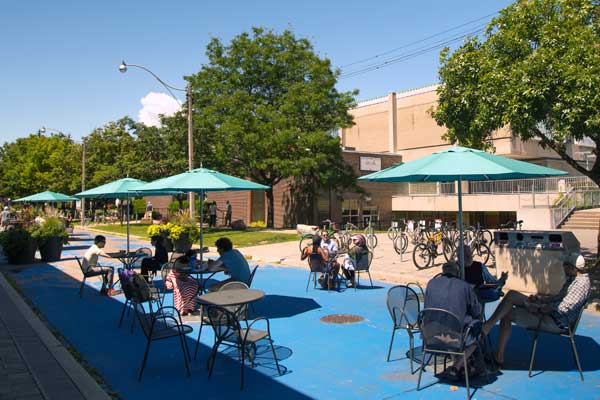
Improving the walking – and learning – environment at U of T's downtown campus
Published: August 6, 2015
An end to parking on King’s College Circle? Pedestrians only on Devonshire Place?
These and other dramatic improvements to the St. George campus are among the options being studied for inclusion in a new strategic document that will be submitted to the city in fall 2015.
“This is the next step from the 2011 Master Plan,” said Christine Burke, director, campus and facilities planning. “It will create an understanding with the city, our neighbours and all people for whom the downtown campus of the University of Toronto is a beautiful and important space.”
Like the Master Plan, the Secondary Plan – a municipal document that identifies land use and growth objectives in a specific part of the city – will reflect the importance of heritage, open spaces and environmental priorities but also allow for flexibility in building and reorganizing the space used by University divisions as they evolve.
“What we are doing now, in consultation with the city and other stakeholders, is evaluating the goals and priorities that should be incorporated into City policy,” Burke said.
While approval of the Secondary Plan ultimately resides with the City of Toronto, it will be developed in consultation with stakeholders, including campus groups and neighbourhood representatives. Crucial input is expected from the U of T Landmark Committee, which has solicited proposals from four competitive teams of urban designers and landscape architects on how to enhance the historical centre of the St. George campus.
Among the priorities foreseen is improving the walking environment west of St. George St. and creating a “heart” for these problematic city blocks, according Pino Di Mascio, a partner in Urban Strategies Inc., which has been retained by the University as a consultant.
“Clearly, Huron St. needs to be rethought,” he told a meeting of U of T Principals, Deans, Academic Directors and Chairs on June 24. “We need better pedestrian amenities, better landscaping.”
Di Mascio said the success of Willcocks Commons – the portion of Willcocks St. closed to traffic – and the redesigned stairs of Sidney Smith Hall have made this stretch of St. George St. more amenable to the pedestrians who continue to dominate the campus.
Russell St. and Devonshire Place (the latter now flanked by the Goldring Centre and Varsity Stadium) are other logical candidates for seasonal pedestrian-only designation, Di Mascio said. It might also be possible to extend Willcocks Commons to Spadina Ave.
The intersection of St. George St., Harbord St. and Hoskin Ave., anchored by the Robarts Library, is inevitably a crossroads of pedestrian traffic, Di Mascio noted.
“Do we need on-street parking on Harbord and Hoskin?” he asked. “Does it add anything to the University?”
One reason for the imperfect development of the west sector of the St. George campus, Di Mascio added, was the expectation in the 1960s and 1970s that Spadina Ave. would become the Spadina Expressway. University structures were built accordingly, with architecturally inexpressive (not to mention inaccessible) western façades.
The areas east of St. George St. are widely agreed to be beautiful and pedestrian-friendly.

Nevertheless, there are potential improvements to be considered, including the end of parking on King’s College Circle and Tower Road and new strategies for pedestrian flow across Queen’s Park.
While U of T officials foresee no rise in overall enrolment, a higher proportion of graduate students (and international students who live on campus) will have a significant effect on space and its use. Graduate studies entail more laboratories, seminar spaces, conference facilities and office space for faculty.
Other needs include improvements to the “edges” of the campus where pedestrians (and the public) gain access to the University, particularly College St and the intersection of Bloor St. and Spadina Ave. On campus, is widely accepted that ground-floor entrances should be vibrant and welcoming, and that architectural quality in general is an important element in a positive learning environment.
Despite these fixed priorities, the Secondary Plan must allow the University to be efficient and adaptable as it responds to changing academic needs over time.
“We don’t know what new programs will emerge,” Burke said. “It is in the nature of learning, research and collaboration for new directions to develop.”
In a question period following the June 24 briefing, Dr. Avrum Gotlieb, vice-dean, research and international relations, recommended that the plan include a statement communicating the University’s academic mission.
Other suggestions arising in question period concerned the clear expression of accessibility as a priority and the need to factor in the construction of new high-rise downtown housing into any consideration of public access to the St. George campus.
“This is a document with many parts, reflecting the complexity of the St. George campus and the University itself,” said Scott Mabury, U of T vice-president of University operations. “Everyone involved is determined to make it as clear and comprehensive as possible.”




